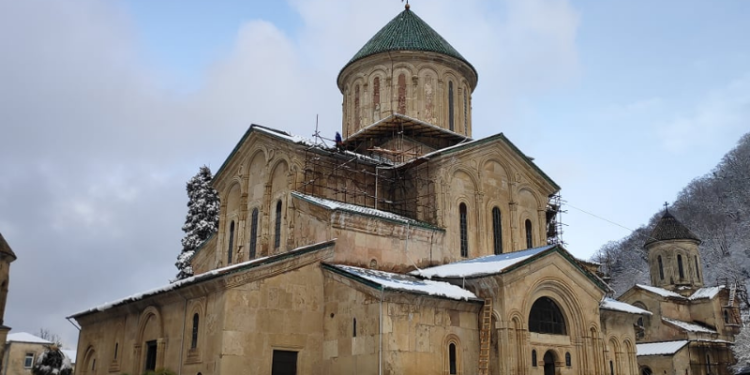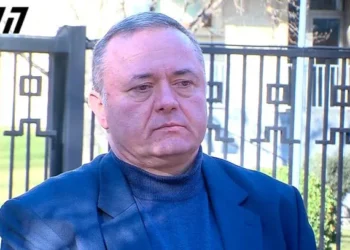The Patriarchate of Georgia issued a statement regarding Gelati Monastery, a medieval monastic complex near Kutaisi in the Imereti region of western Georgia.
According to the statement, the Ministry of Culture’s advocacy of the conservation group working in Gelati today is “incomprehensible.”
The Patriarchate considers that the situation is not only serious, but critical, and therefore says it is necessary to urgently change the situation and save the frescoes within.
The Patriarchate says it believes that the mentioned group should be replaced by specialists with higher competence.
The Patriarchate declares that the concurrence of the reports of international experts and Georgian scientists calls into question the expediency of continuing conservation work by the currently operating group of specialists.
According to the statement, it is necessary to carry out the rehabilitation of Gelati with a unified management plan in accordance with modern standards. An international advisory board should be established, which, together with the country’s field scientists, will closely cooperate with an integrated group of invited highly qualified and local renovators, it says.
The Patriarchate offers open and impartial dialogue to all interested parties.
“The crisis of the 21st century of the Gelati Cathedral began as a result of the rehabilitation works carried out in 2015-19. The roofing of the temple’s wings and outbuilding was carried out with the wrong methodology, low-quality materials and an unprofessional approach. In the structure of the temple, from the works performed on the roof and the impact of natural precipitation, water seepage – infiltration started. By 2021, the paintings of the Gelati wall were in a serious condition. The process of salting and damage to the paintings appeared in the interior of the temple.
There is nothing unclear or vague in the assessment of this period.
Based on the created situation, it became clear that considering the complexity and extent of damage to the paintings, it was necessary to invite highly qualified foreign specialists, who would have the appropriate competence and technical resources, and who, together with local specialists, would treat and save Gelati’s paintings.
It is from this stage that today’s difference in positions begins, which is connected to the work of the group invited for the conservation of Gelati wall paintings in the summer of 2021.
Despite their work, Gelati’s wall paintings have reached a critical state.
We face the production of incomplete, scarce documentation. This is demonstrated by all four highly qualified reports, namely: by Steven Rickerby and Lisa Shekedes (commissioned by the Ministry of Culture itself); A report by internationally recognized scholars invited by the Patriarchate: Austin Nevin, Lorinda Wong, Sarah Staniforth and Francesca Pique; Also, the conclusion about conservation prepared by “Icomos Georgia” executed at our request; And also on the basis of our appeal, – a voluminous work created by the Chubinashvili Center.
These four reports come in a unified and identical position to the report of the experts appointed by UNESCO, who carried out their mission in Gelati between November 28 and December 2, 2022. For a clear illustration, we will quote a few excerpts from the UNESCO expert report:
“A thorough assessment of the conservation treatments undertaken on the mural paintings in the Main Church are hampered by the apparent lack of documentation related to their condition assessment and the past interventions, as well as by the lack of analysis of the plaster and painting techniques. Nevertheless, concerns can be confidently expressed regarding the approach and selection of some of the materials and techniques for emergency interventions on the wall paintings in the upper part of the west wing.
“Another matter of concern is the apparent lack of documentation regarding the condition assessment of the mural paintings
“Another issue of concern is the lack of analysis of the plaster and painting techniques, particularly of those in the upper parts of the vaults, but necessary for all mural paintings, in order to better assess and correlate painting techniques, phenomena of alteration and decay, and possible conservation treatment.
We do not enter into professional and scientific discussions and evaluations of conservation – restoration and art studies, this is beyond our competence, however, the concurrence of the reports of international experts and Georgian scientists at our disposal calls into question the feasibility of continuing the conservation work by the currently operating group of specialists.
It is necessary to comply with modern standards, to produce a unified management plan for the rehabilitation of Gelati. An international advisory board should be created, which, together with the scientists of our country, will cooperate closely with an integrated group of invited highly qualified and local restorers.
We also want to touch on the general problems created around Gelati.
The UNESCO expert group was invited to Georgia by the Ministry of Culture, hugely important for the in-depth study of the Gelati problem was the letter sent by His Holiness and Beatitude Ilia II, the Catholicos-Patriarch of All Georgia on 30.09.2022, Mr. Lazare Elundu Assomosa, Director of the UNESCO World Cultural Heritage Center, and to Mrs. Teresa Patricia, President of ICOMOS. His Holiness requested that the matter be thoroughly studied.
Based on the strong criticality of the report provided by UNESCO, as well as other expert conclusions and recommendations mentioned above, it is not clear to us the advocacy of the conservation group working today on the part of the Ministry of Culture.
The situation is not only serious, but critical! It is necessary to immediately correct the created situation and save the paintings! We believe that the mentioned group should be replaced by specialists with higher competence.
We appeal to political parties and TV stations, equally to everyone, not to be biased and not to approach this general Georgian issue with narrow interests. The Patriarchate offers open and impartial dialogue to all interested parties. Let’s talk calmly and in the best interests of Gelati. As a result of the right cooperation, the created critical situation is surmountable and solvable. We kindly ask you to understand our request,” the statement reads.
One of the first monasteries in Georgia, Gelati was founded in 1106 by King David IV of Georgia as a monastic and educational center. The monastery is an exemplar of the Georgian Golden Age and a gold aesthetic is employed in the paintings and buildings. It was built to celebrate Orthodox Christian faith in Georgia. Some murals found inside the Gelati Monastery church date back to the 12th century. The monastery was inscribed as a UNESCO World Heritage Site in 1994 because of its outstanding architecture and its importance as an educational and scientific center in medieval Georgia.














